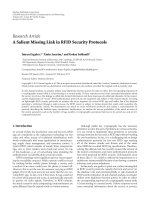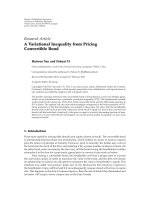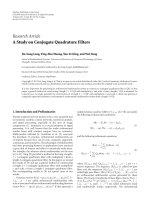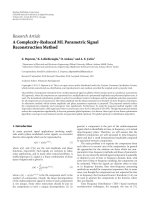Báo cáo hóa học: " Research Article A Study on the p-Adic q-Integral Representation on p Associated with the Weighted q-Bernstein and q-Bernoulli Polynomials" pot
Bạn đang xem bản rút gọn của tài liệu. Xem và tải ngay bản đầy đủ của tài liệu tại đây (488.06 KB, 8 trang )
Hindawi Publishing Corporation
Journal of Inequalities and Applications
Volume 2011, Article ID 513821, 8 pages
doi:10.1155/2011/513821
Research Article
A Study on the p-Adic q-Integral Representation on
p
Associated with the Weighted q-Bernstein and
q-Bernoulli Polynomials
T. Kim,
1
A. Bayad,
2
and Y H. Kim
1
1
Division of General Education-Mathematics, Kwangwoon University, Seoul 139-701, Republic of Korea
2
D
´
epartement de Ma th
´
ematiques, Universit
´
e d’Evry Val d’Essonne, Boulevard Franc¸ois Mitterrand,
91025 Evry Cedex, France
Correspondence should be addressed to A. Bayad,
Received 6 December 2010; Accepted 15 January 2011
Academic Editor: Vijay Gupta
Copyright q 2011 T. Kim et al. This is an open access article distributed under the Creative
Commons Attribution License, which permits unrestricted use, distribution, and reproduction in
any medium, provided the original work is properly cited.
We investigate some interesting properties of the w eighted q-Bernstein polynomials related to the
weighted q-Bernoulli numbers and polynomials by using p-adic q-integral on
p
.
1. Introduction and Preliminaries
Let p be a fixed prime number. Throughout this paper,
p
,
p
,and
p
will denote the ring
of p-adic integers, the field of p-adic rational numbers, and the completion of the algebraic
closure of
p
, respectively. Let be the set of natural numbers, and let
∪{0}.Letν
p
be the normalized exponential valuation of
p
with |p|
p
p
−ν
p
p
1/p.Letq be regarded
as either a complex number q ∈
or a p-adic number q ∈
p
.Ifq ∈ ,thenwealways
assume |q| < 1. If q ∈
p
, we assume that |1 − q|
p
< 1. In this paper, we define the q-number
as x
q
1 − q
x
/1 − qsee 1–13.
Let C0, 1 be the set of continuous functions on 0, 1.Forα ∈
and n, k ∈
,the
weighted q-Bernstein operator of order n for f ∈ C0, 1 is defined by
α
n,q
f | x
n
k0
f
k
n
n
k
x
k
q
α
1 − x
n−k
q
−α
n
k0
f
k
n
B
α
k,n
x, q
. 1.1
Here B
α
k,n
x, q is called the weighted q-Bernstein polynomials of degree n see 2, 5, 6.
2 Journal of Inequalities and Applications
Let UD
p
be the space of uniformly differentiable functions on
p
.Forf ∈ UD
p
,
the p-adic q-integral on
p
, which is called the bosonic q-integral on
p
,isdefinedby
I
q
f
p
f
x
dμ
q
x
lim
N →∞
1
p
N
q
p
N
−1
x0
f
x
q
x
, 1.2
see 10.
The Carlitz’s q-Bernoulli numbers are defined by
β
0,q
1,q
qβ 1
k
− β
k,q
1, if k 1,
0, if k>1,
1.3
with the usual convention about replacing β
k
by β
k,q
see 3, 9, 10.In3, Carlitz also defined
the expan sion of Carlitz’s q-Bernoulli numbers as follows:
β
h
0,q
h
h
q
,q
h
qβ
h
1
n
− β
h
n,q
1, if n 1,
0, if n>1,
1.4
with the usual convention about replacing β
h
n
by β
h
n,q
.
The weighted q-Bernoulli numbers are constructed in previous paper 6 as follows:
for α ∈
,
β
α
0,q
1,q
q
α
β
α
1
n
−
β
α
n,q
⎧
⎨
⎩
α
α
q
, if n 1,
0, if n>1,
1.5
with the usual convention about replacing
β
α
n
by
β
α
n,q
.Letf
n
xfx n.Bythe
definition 1.2 of p-adic q-integral on
p
, we easily get
qI
q
f
1
q lim
N →∞
1
p
N
q
p
N
−1
x0
f
x 1
q
x
,
lim
N →∞
1
p
N
q
p
N
−1
x0
f
x
q
x
lim
N →∞
f
p
N
q
p
N
− f
0
p
N
q
p
f
x
dμ
q
x
q − 1
f
0
q − 1
log q
f
0
,
1.6
Continuing this process, we obtain easily the relation
q
n
p
f
n
x
dμ
q
x
−
p
f
x
dμ
q
x
q − 1
n−1
l0
q
l
f
l
q − 1
log q
n−1
l0
q
l
f
l
, 1.7
where n ∈
and f
ldf l/dx see 6.
Journal of Inequalities and Applications 3
Then by 1.2, applying to the function x → x
n
q
α
,wecanseethat
β
α
n,q
p
x
n
q
α
dμ
q
x
−
nα
α
q
∞
m0
q
mαm
m
n−1
q
α
1 − q
∞
m0
q
m
m
n
q
α
. 1.8
The weighted q-Bernoulli polynomials are also defined by the generating function as
follows:
F
α
q
t, x
−t
α
α
q
∞
m0
q
mαm
e
mx
q
α
t
1 − q
∞
m0
q
m
e
mx
q
α
t
∞
n0
β
α
n,q
x
t
n
n!
,
1.9
see6. Thus, we note that
β
α
n,q
x
n
l0
n
l
x
n−l
q
α
q
αlx
β
α
l,q
−
nα
α
q
∞
m0
q
mαm
m x
n−1
q
α
1 − q
∞
m0
q
m
m x
n
q
α
.
1.10
From 1.2 and the previous equalities, we obtain the Witt’s formula for the weighted
q-Bernoulli polynomials as follows:
β
α
n,q
x
p
x y
n
q
α
dμ
q
y
n
l0
n
l
q
αlx
x
n−l
q
α
p
y
l
q
α
dμ
q
y
. 1.11
By using 1.2 and the weighted q-Bernoulli polynomials, we easily get
q
n
β
α
m,q
n
−
β
α
m,q
q − 1
n−1
l0
q
l
l
m
q
α
mα
α
q
n−1
l0
q
αll
l
m−1
q
α
, 1.12
where n, α ∈
and m ∈
see 6.
In this paper, we consider the weighted q-Bernstein polynomials to express the bosonic
q-integral on
p
and investigate some properties of the weighted q-Bernstein polynomials
associated with the weighted q-Bernoulli polynomials by using the expression of p-adic q-
integral on
p
of those polynomials.
2. Weighted q-Bernstein Polynomials and q-Bernoulli Polynomials
In this section, we assume that α ∈ and q ∈
p
with |1 − q|
p
< 1.
Now we consider the p-adic weighted q-Bernstein operator as follows:
α
n,q
f | x
fx
n
k0
f
k
n
n
k
x
k
q
α
1 − x
n−k
q
−α
n
k0
f
k
n
B
α
k,n
x, q
. 2.1
4 Journal of Inequalities and Applications
The p-adic q-Bernstein polynomials with weight α of degree n are given by
B
α
k,n
x, q
n
k
x
k
q
α
1 − x
n−k
q
−α
, 2.2
where x ∈
p
, α ∈ ,andn, k ∈
see 6, 7.NotethatB
α
k,n
x, qB
α
n−k,n
1 − x, 1/q.That
is, the weighted q-Bernstein polynomials are symmetric.
From the definition of the weighted q-Bernoulli polynomials, we have
β
α
n,q
−1
1 − x
−1
n
q
αn
β
α
n,q
x
. 2.3
By the definition of p-adic q-integral on
p
,weget
p
1 − x
n
q
−α
dμ
q
x
q
αn
−1
n
p
−1 x
n
q
α
dμ
q
x
p
1 −
x
q
α
n
dμ
q
x
.
2.4
From 2.3 and 2.4,wehave
p
1 − x
n
q
−α
dμ
q
x
n
l0
n
l
−1
l
β
α
l,q
q
αn
−1
n
β
α
n,q
−1
β
α
n,q
2
. 2.5
Therefore, we obtain the following lemma.
Lemma 2.1. For n ∈
,onehas
p
1 − x
n
q
−α
dμ
q
x
n
l0
n
l
−1
l
β
α
l,q
q
αn
−1
n
β
α
n,q
−1
β
α
n,q
2
,
β
α
n,q
−1
1 − x
−1
n
q
αn
β
α
n,q
x
.
2.6
By 2.2, 2.3,and2.4,weget
q
2
β
α
n,q
2
n
α
α
q
q
1α
q
2
− q
β
α
n,q
, if n>1. 2.7
Thus, we have
β
α
n,q
2
1
q
2
β
α
n,q
nα
α
q
q
α−1
1 −
1
q
, if n>1. 2.8
Therefore, by 2.8, we obtain the following proposition.
Journal of Inequalities and Applications 5
Proposition 2.2. For n ∈
with n>1,onehas
β
α
n,q
2
1
q
2
β
α
n,q
nα
α
q
q
α−1
1 −
1
q
. 2.9
By using Proposition 2.2 and Lemma 2.1, we obtain the following corollary.
Corollary 2.3. For n ∈
with n>1,onehas
p
1 − x
n
q
−α
dμ
q
x
q
2
β
α
n,q
−1
nα
α
q
1 − q, 2.10
p
1 − x
n
q
−α
dμ
q
x
nα
α
q
1 − q q
2
p
x
n
q
−α
dμ
q
−1
x
p
1 −
x
q
α
n
dμ
q
x
.
2.11
Taking the bosonic q-integral on
p
for one weighted q-Bernstein polynomials in 2.1,
we have
p
B
α
k,n
x, q
dμ
q
x
n
k
p
x
k
q
α
1 − x
n−k
q
−α
dμ
q
x
n
k
n−k
l0
n − k
l
−1
l
p
x
kl
q
α
dμ
q
x
n
k
n−k
l0
n − k
l
−1
l
β
α
kl,q
.
2.12
By the symmetry of q-Bernstein polynomials, we get
p
B
α
k,n
x, q
dμ
q
x
p
B
α
n−k,n
1 − x,
1
q
dμ
q
x
n
k
k
l0
k
l
−1
kl
p
1 − x
n−l
q
−α
dμ
q
x
.
2.13
6 Journal of Inequalities and Applications
For n>k 1, by 2.11 and 2.13,wehave
p
B
α
k,n
x, q
dμ
q
x
n
k
k
l0
k
l
−1
kl
nα
α
q
1 − q q
2
p
x
n−l
q
−α
dμ
q
−1
x
⎧
⎪
⎪
⎪
⎪
⎪
⎨
⎪
⎪
⎪
⎪
⎪
⎩
nα
α
q
1 − q q
2
β
α
n,q
−1
, if k 0,
⎛
⎝
n
k
⎞
⎠
q
2
k
l0
⎛
⎝
k
l
⎞
⎠
−1
kl
β
α
n−l,q
−1
,
if k>0.
2.14
By comparing the coefficients on the both sides of 2.12 and 2.14,weobtainthe
following theorem.
Theorem 2.4. For n, k ∈
with n>k 1,onehas
n−k
l0
n − k
l
−1
l
β
α
kl,q
q
2
k
l0
k
l
−1
kl
β
α
n−l,q
−1
, if k
/
0. 2.15
In particular, when k 0,onehas
nα
α
q
1 − q q
2
β
α
n,q
−1
n
l0
n
l
−1
l
β
α
l,q
. 2.16
Let m, n, k ∈
with m n>2k 1. Then we see that
p
B
α
k,n
x, q
B
α
k,m
x, q
dμ
q
x
n
k
m
k
p
x
2k
q
α
1 − x
nm−2k
q
−α
dμ
q
x
n
k
m
k
2k
l0
2k
l
−1
l2k
p
1 − x
nm−l
q
−α
dμ
q
x
.
n
k
m
k
2k
l0
2k
l
−1
l2k
nα
α
q
1 − q q
2
p
x
nm−l
q
−α
dμ
q
−1
x
n
k
m
k
2k
l0
2k
l
−1
l2k
nα
α
q
1 − q q
2
β
α
nm−l,q
−1
.
2.17
Therefore, by 2.17, we obtain the following theorem.
Journal of Inequalities and Applications 7
Theorem 2.5. For m, n, k ∈
with m n>2k 1,onehas
p
B
α
k,n
x, q
B
α
k,m
x, q
dμ
q
x
⎧
⎪
⎪
⎪
⎪
⎨
⎪
⎪
⎪
⎪
⎩
nα
α
q
1 − q q
2
β
α
nm,q
−1
, if k 0,
⎛
⎝
n
k
⎞
⎠
⎛
⎝
m
k
⎞
⎠
q
2
2k
l0
⎛
⎝
2k
l
⎞
⎠
−1
l2k
β
α
nm−l,q
−1
, if k
/
0.
2.18
For m, n, k ∈
,wehave
p
B
α
k,n
x, q
B
α
k,m
x, q
dμ
q
x
n
k
m
k
p
x
2k
q
α
1 − x
nm−2k
q
−α
dμ
q
x
n
k
m
k
nm−2k
l0
n m − 2k
l
−1
l
p
x
2kl
q
α
dμ
q
x
n
k
m
k
nm−2k
l0
n m − 2k
l
−1
l
β
α
l2k,q
.
2.19
Therefore, by 2.18 and 2.19, we obtain the following theorem.
Theorem 2.6. For m, n, k ∈
with m n>2k 1,onehas
nα
α
q
1 − q q
2
β
α
nm−l,q
−1
nm
l0
n m
l
−1
l
β
α
l,q
. 2.20
Furthermore, for k
/
0,onehas
nm−2k
l0
n m − 2k
l
−1
l
β
α
l2k,q
q
2
2k
l0
2k
l
−1
l2k
β
α
nm−l,q
−1
. 2.21
By the induction hypothesis, we obtain the fo llowing theorem.
Theorem 2.7. For s ∈
and k, n
1
, ,n
s
∈
with n
1
n
2
··· n
s
>sk 1,onehas
p
s
i1
B
α
k,n
i
x, q
dμ
q
x
⎧
⎪
⎪
⎪
⎪
⎨
⎪
⎪
⎪
⎪
⎩
nα
α
q
1 − q q
2
β
α
n
1
···n
s
,q
−1
, if k 0,
⎛
⎝
s
i1
⎛
⎝
n
i
k
⎞
⎠
⎞
⎠
sk
l0
⎛
⎝
sk
l
⎞
⎠
−1
lsk
β
α
n
1
···n
s
−l,q
−1
, if k
/
0.
2.22
8 Journal of Inequalities and Applications
For s ∈
,letk, n
1
, ,n
s
∈
with n
1
n
2
··· n
s
>sk 1. Then we show that
p
s
i1
B
α
k,n
i
x, q
dμ
q
x
s
i1
n
i
k
n
1
···n
s
−sk
l0
n
1
··· n
s
− sk
l
−1
l
β
α
lsk,q
.
2.23
Therefore, by Theorem 2.7 and 2.23, we obtain the following theorem.
Theorem 2.8. For s ∈
,letk, n
1
, ,n
s
∈
with n
1
n
2
··· n
s
>sk 1. Then one sees that
for k 0
n
1
···n
s
l0
n
1
··· n
s
l
−1
l
β
α
l,q
nα
α
q
1 − q q
2
β
α
n
1
···n
s
,q
−1
. 2.24
For k
/
0,onehas
sk
l0
sk
l
−1
lsk
β
α
n
1
···n
s
−l,q
−1
n
1
···n
s
−sk
l0
n
1
··· n
s
− sk
l
−1
l
β
α
lsk,q
. 2.25
References
1 M. Acikgoz and Y. Simsek, “On multiple interpolation functions of the N
¨
orlund-type q-Euler
polynomials,” Abstract and Applied Analysis, vol. 2009, Arti cle ID 382574, 14 pages, 2009.
2 A.Bayad,J.Choi,T.Kim,Y H.Kim,andL.C.Jang,“q-extension of Bernstein polynomials with
weighted α;β,” Journal of Computational and Applied Mathematics. In press.
3 L. Ca rlitz, “Expansions of q-Bernoulli numbers,” Duke Mathematical Journal, vol. 25, pp. 355–364, 1958.
4 A. S. Hegazi and M. Mansour, “A note on q-Bernoulli numbers and polynomials,” Journal of Nonlinear
Mathematical Physics, vol. 13, no. 1, pp. 9–18, 2006.
5 L C. Jang, W J. Kim, and Y. Simsek, “A study on the p-adic integral representation on
p
associated
with Bernstein and Bernoulli polynomials,” Advances in Difference Equations, vol. 2010, Article ID
163217, 6 pages, 2010.
6 T. Kim, “On the weighted q-Bernoulli numbers a nd polynomials,” g /abs/1011.5305.
7 T. Kim, “A note on q-Bernstein polynomials,” Russian Journal of Mathematical Physics, vol. 18, no. 1,
2011.
8 T. Kim, “Barnes-type multiple q-zeta fun ctions and q-Euler polynomials,” Journal of Physics A,vol.43,
no. 25, Article ID 255201, 11 pages, 2010.
9 T. Kim, “q-Bernoulli numbers and polynomials associated with Gaussian binomial coefficients,”
Russian Journal of Mathematical Physics, vol. 15, no. 1, pp. 51–57, 2008.
10 T. Kim, “On a q-analogue of the p-adic log gamma functions and related integrals,” Journal of Number
Theory, vol. 76, no. 2, pp. 320–329, 1999.
11 B. A. Kupershmidt, “Reflection symmetries of q-Bernoulli polynomials,” Journal of Nonlinear
Mathematical Physics, vol. 12, supplement 1, pp. 412–422, 2005.
12 H. Ozden, I. N. Ca ngul, and Y. Simsek, “Remarks on q-Bernoulli numbers associated with Daehee
numbers,” Advanced Studies in Contemp orary Mathematics, vol. 18, no. 1, pp. 41–48, 2009.
13 S H. Rim, J H. Jin, E J. Moon, and S J. Lee, “On multiple interpolation functions of the q-Genocchi
polynomials,” Journal of Inequalities and Applications, vol. 2010, Article ID 351419, 13 pages, 2010.









